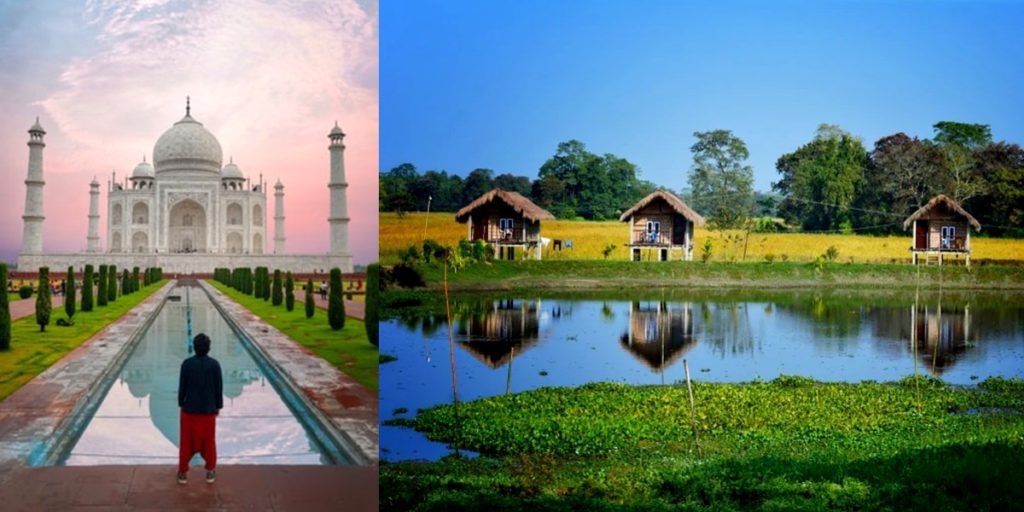India is blessed with pristine islands, exotic animals, lush green forests and even landmarks with marvellous architecture. But did you know that some of our country’s most well known natural and manmade wonders are in danger of becoming extinct? So, there’s an increased need to visit these places as soon as possible before they vanish forever. Here are 6 such endangered places in India that must top your bucket list asap.
1. Taj Mahal In Uttar Pradesh
Now, this might come as a shock to you, but the magnificent Taj Mahal in Agra is under threat. The drying up of Yamuna river is posing a risk to the very foundation of Taj Mahal. The foundation of this historic monument is built on massive wooden shafts. And these need moisturisation by the river water to hold the monument in place. The decrease in water flow has led to the shrinking of the wooden shafts over the years. The lack of water also results in algae and bugs encroaching the foundation of the monument, eroding it from the bottom and hampering its beauty. So, river water from the Yamuna is necessary for the survival of Taj Mahal.
Also Read: Taj Mahal Witnessed Less Than 1 Percent Of Foreign Tourists In 2020
2. Majuli Island In Assam
Assam’s Majuli island was one of the largest river islands, covering a stretch of 1200 sq km. It houses more than 260 specifies of birds and was a biodiversity hotspot. Today, it’s, unfortunately, one of the fast-disappearing islands, spanning a miserable 400 sq km. Massive soil erosions and dreadful flooding has led to the submerging of the island. Regular floods in the Brahmaputra has eroded soil, washed away villages and displaced residents. The rate of erosion is so devastating that it will likely submerge the entire island in the next 15-20 years, according to Majuli Island Protection & Development Council, a non-profit. Do ensure you don’t miss out on this melting pot of Assamese culture on your next visit to the Northeast.
Also Read: 10 Gorgeous Countries With High Rupee Value Where You Can Travel Like Royalty
3. Sundarbans In West Bengal
When it comes to national parks in India, Sunderbans in West Bengal always stands tall as one of the best in India. It’s the world’s largest area of mangrove forests and houses many endangered species. But over the years, pollution, climate change and deforestation have led to rising sea levels, threatening the very existence of Sunderbans. Illicit logging to build concrete jungles, booming population, poaching and encroaching for fossil fuels has made Sunderbans an endangered forest. Infact the very tree species of sundari, after which the forest has been named, is under threat.
Also Read: 6 Best Dishes To Try In Lucknow Apart From The Legendary Lucknowi Biryani
4. Kothi At Qila Mahmudabad In Uttar Pradesh
Kothi was part of a 20-acre complex of Qila Mahmudabad Estate founded by Raja Mahmud Khan in 1677. It’s a perfect embodiment of Awadh architecture. This served as a residential and administrative abode for many kings of the Mahmudabad throughout the Mughal era. However, during the First War of Independence in 1857, it was completely shattered by the British and then rebuilt again soon after. Kothi today, hosts Urdu and Arabic books of the finest grade. Scholars of literature, art and poetry flock here from across the world. But this 67,650 square feet area has faced harsh neglect, ageing and seismic shocks. World Monuments Fund ( WMF) as a result, has featured it in its endangered list today.
5. Shimla Civic Centre In Himachal Pradesh
In the early 19th century, the Shimla Civic Centre was a charming and beautiful town hall. Later it transformed into a summer retreat for the British in the 1830s. Colonial style buildings were constructed and the city got an old-world charm that’s still appreciated to date. But the town’s historic beauty faced deterioration due to lack of maintenance in the area and unplanned urban development. WMF has listed Shimla Civic Centre in its risk list for the same. A trip to Shimla must be on the cards to just explore this townhall before its buildings deteriorate over time.
Also Read: Ladakh To Become India’s Astro-Tourism Hub; Tourists Can Stargaze In Pollution-Free Sky
6. Hemis National Park In Ladakh
You might want to visit Ladakh for its eternal beauty. But wildlife enthusiasts make note! This union territory houses the breathtaking Hemis National Park. The altitude park is famous across the world fro housing snow leopards. Infact Hemis National Park is believed to have the highest density of these magnetic creatures in any protected area in the world. Unfortunately, the number of snow leopards in this national park is dwindling over the years. So just like the endangered animal it houses, the park has also become an endangered landmark in India. Spot the wild cat, capture mesmerising photos and be part of an adventure, before its too late.
So, travel enthusiasts, these are some of the endangered places in India you must visit before they disappear. Make your plans beforehand and have a trip of a lifetime here.

